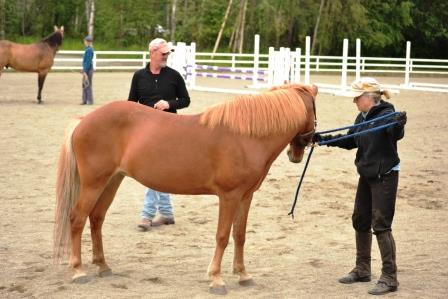
Home > Dispatches > Daily Dispatches 2014 > Daily Dispatch #201
July 21, 2014: Lessons Learned: First Day of Jim Briggs Clinic
’ve always wanted to do a Jim Briggs clinic. Jim Briggs is this fellow who comes up from the Lower 48 and works with the local hunter/jumper/dressage crowd’s horses. I presumed that I could not do this because Raudi and I had (at least until May) no jumping experience. However, Vicki Talbot opened the door for me by alerting me to the fact that he was doing a clinic this week. I decided to go for it, but not without some reservations. First of all, Raudi and I have just two months of jumping experience under our girth, and this experience consists of going over little cross jumps. And secondly, Raudi’s |
|
| behavior has been less than stellar these past few days. She’s been anxious, restless, and can’t seem to hold still. I also had my reservations about today’s morning session, which proved to be true. We were to do groundwork—a la natural horsemanship methods. Essentially, Icelandic horses, who are very smart, do not take to this particular sort of training, which is training that complements the belief that horses (prey animals) must submit and do what’s asked of them. Horses, then, aren’t partners, but rather beasts of burden. This sort of training involves getting in the horses’ space, and through the use of ropes and waving hands, gets them to back, turn on the forehand, and turn on the hindquarters. It also, at times, involves using a round pen and getting the horse to “join up,” which is after running around a bit, give in to the demands of the round pen trainer. I tried a few things with Raudi, who has never taken to this particular type of training. The clinician attempted to get her to turn on the forehand, by waving rope and hands in her face. I saw her confused wild eyed look, and again (as I have in the past) vowed to never again let anyone else ground train her in such a fashion. I did wave the rope at her, to get her to back, but she also would have no part of this. I ended up doing as I’d learned, which is having her follow my extended hand. No one noticed, but in the end she and I walked and trotted nicely around the arena, her stopping when I stopped. Right here, end of her and my confusion. Afternoon was better. I don’t see any similarity between the natural horsemanship method of standing on the ground and doing turns on the forehand and haunches and doing this in the saddle. You can’t wave a hand in a horse’s face when you are in the saddle, nor can you use your legs. Rather, you simply use body movements. I did not get to ask the clinician this. Rather, I did as told. The high point came when, finally, I asked clinician how to do a half halt. “Body, seat, legs,” he said. What he meant by this was put weight in your seat, squeeze your legs, and squeeze the reins. This then is an indication to the horse that another cue is to follow. This worked really, really well – and it is something that I’ve added to my tack box. In fact, it was well worth the price of clinic admission. Next: 202. 7/ 23/14: Lessons Learned: Putting Theory to Practice |
|
